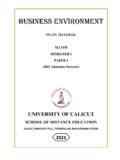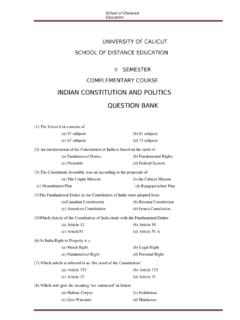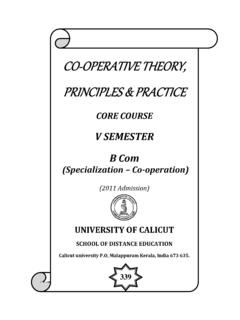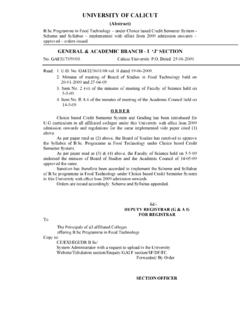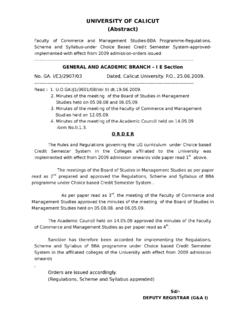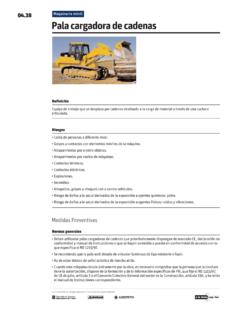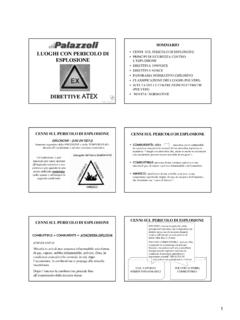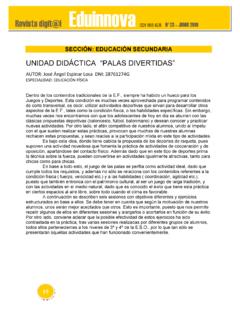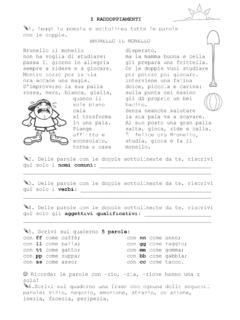Transcription of MEDIEVAL INDIA: SOCIETY, CULTURE AND RELIGION
1 MEDIEVAL india : society , CULTUREANDRELIGIONSTUDY MATERIALV SEMESTERCORE (2011 Admission onwards)UNIVERSITY OF CALICUTSCHOOL OF DISTANCE EDUCATIONCALICUT UNIVERSITY , THENJIPALAM,MALAPPURAM, KERALA-679 635238 School of Distance EducationMedieval india : society , CULTURE and ReligionPage2 UNIVERSITY OF CALICUTSCHOOL OF DISTANCE EDUCATIONV SEMESTER CORE HISTORYMEDIEVAL india : society , CULTURE AND RELIGIONP repared & Scrutinized of , out & printingComputer Section, of Distance EducationMedieval india : society , CULTURE and ReligionPage3 UNITCONTENTPAGEI NATUREOF STATE05-27II ELEMENTS OF FEUDALISM IN NORTH INDIAN SOCIETY28-55 III ASPECT OF MUGHAL RULE56-91IV STATE AND society IN SOUTH INDIA92-113 School of Distance EducationMedieval india : society , CULTURE and ReligionPage4 School of Distance EducationMedieval india .
2 society , CULTURE and ReligionPage5 UNIT-INATURE OF STATEThe MEDIEVAL Period of Indian History comprises a long period, spanning the fall of the Gupta Empire to the 18thcentury, thebeginning of colonial historians, for the convenience ofstudying the state and society of MEDIEVAL india , usually divide the period intoEarly MEDIEVAL Period and Late MEDIEVAL Period. According to them the EarlyMedieval period refer to the phase of Indian history that stretches from the fallof the GuptaEmpireto the beginning of the Sultanate period in the 13thcentury. The period that comprises mainly that of the reigns of the Sultanateand the Mughal period is generally consideredas the late MEDIEVAL period, ofcourse with regional nature of state in the early MEDIEVAL period is marked by the presence ofa large number of regional and local powers, in the absence of a paramountpower in the country.
3 However, this period witnessed the presence of formidablepolitical entities, often characterized by certain historians as regional imperialkingdoms .But in the late MEDIEVAL period, especially in the Sultanate andMughal reigns, high level of centralization of power is identifies, that too in themajor parts of the Indian sub historiography tried to view the entire MEDIEVAL period as one andalso tried to establish the existence of centralized empire, as a continuation ofthe ancient empires, thereby negating the elements of changes that took placein the nature of state during the followed the tripartite division ofthe colonial historians.
4 With certain qualitative Marxist historiographyin general stressed on the traits of decentralized fragmented policy during theperiod under discussion, which itself pointed to certain structural changes inthe political life of the salient feature of the Marxist approach is toidentify the institution of land-grants as the principal agents of changebringing in parcellised this perspective the early MEDIEVAL periodis equated with feudal explains the multiplicity of political powers inIndia, especially during the early MEDIEVAL feudal model was largely constructed on the basis of Puranic andEpigraphic data pertaining mostly to North india and so it is criticized byanother Segmentary State drawing information from a large body ofSouth Indian , feudal and segmentary models aremutually critical of each other, there is a commonality in their emphasis on the fragmented political authority and therefore argued forpolitical crisis and ritual of Distance EducationMedieval india .
5 society , CULTURE and ReligionPage6 Both the models of feudal polity and segmentary state have received critiquesfrom non-aligned historians who demonstrated the distinct element of integrative polity , which had facilitated the emergence of the state societies atlocal and supra-local to them the emergence of these statesocieties resulted from the developments from within at the local level itself andnot because of any external Ruling FamiliesThe history of Indian MEDIEVAL period was started after the endof ancient agein 550 AD and it continued till 18th century when the Mughol Empire this long time period different dynasties rose in power and took acommanding role in the Indian MEDIEVAL land of india was separatedas various small kingdoms from north to south and
6 East to west and thosekingdoms were ruled by different independent the MEDIEVAL history a number of dominant dynasties, namely,the Cholas (3rd century to 13th century) of southern india , theMughuls (1526AD to 1707 AD) of northern india , the Rajput of western india (the state ofRajasthan), the Pala dynasty of eastern india , the Chalukays, the Pallavas, theDelhi Sultanshad control their own area. Some time they made a number ofbloody battles for different dynastyhola DynastyItwas one of the longest ruling powers in south india . Initially they rose inpower of the state of Tamil at the 2nd century BC in time of Indian ancienthistory and they were able to maintain their control until the 13th Cholas kept theirreal evidence in the Sangam literature.
7 It reports thenames of the kings and the princes of Chola dynasty till 300 BC. There had twotypesof Cholas existed in the Dynasty; Karikala Cholas and control their kingdom from two capitalcity; Urayur (now inThiruchirapalli) and Kaveripattinam. A Chola king was known as Elara. Afterthe Sangam age (after 300 BC) Cholas was beaten by the Pandyas and Pallavasand they captured the Tamil country. An unknown dynasty, Kalabhras,attacked the country and displaced the existing empires and ruled for aroundthree 6th century the Pallavas and the Pandyas regained the century.
8 Butthere was a little known of Cholas during the succeeding three centuries untilthe attainment of Vijayalaya in 850 AD. Around 850 AD, Vijayalaya rose inpower and he rescued the Chola Dynasty from Pandyas and Pallavas andSchool of Distance EducationMedieval india : society , CULTURE and ReligionPage7captured yhe capital city Thanjavur and established the line of the medievalCholas. After 9th century, Cholas became strongest dynasty of the southernIndia and they control a wide range of region in total southern india and thesurroundings state. Under Rajaraja Chola I and Rajendra Chola I, the empirebecame powerful in the field of army, finance and CULTURE in South Asia andSouth-east Asia.
9 The Pandyas in south india rose to the position of a largepower who expelled the Hoysala Dynasty who were partners of the Cholas fromTamil country and subsequently causing the end of the Cholas themselves in1279 Chalukya DynastieslukyaDynastiesThe Chalukya Dynasties were in power of Indian MEDIEVAL history from thereign of 600 to 1200 AD in the state of ruled the kingdom from anumber of capital city. Western Chalukyas ruled from Badami. The Chalukyaswho ruled from Kalyani capital city were referred as Later Western Chalukyasand the Chalukyas ruled their kingdom from the Vengi capital city were knownas the Eastern Chalukyas.
10 The founder of the Western or Early ChalukyaDynasty was Pulakesin I who established the dynasty at the capital of Badami(now in Bijapur) after that his son Pulakesin II II was in power in the reigned of 609 AD to 642 AD. The capital ofBadami was destryed by the Pallava Dynasty in the 7th century. The EasternChalukya dynasties were in power form the capital city of Vengi (now in EastAndhra Pradesh) and the dynasty was lasted from 624 AD to Chalukyas was lasted till 7th century from the capital city ofBadami, after a long time period in 973 AD theyhad rescued their capitalBadami and reestablished the dynasty in the Deccan and created a new capitalat Kalyani.
